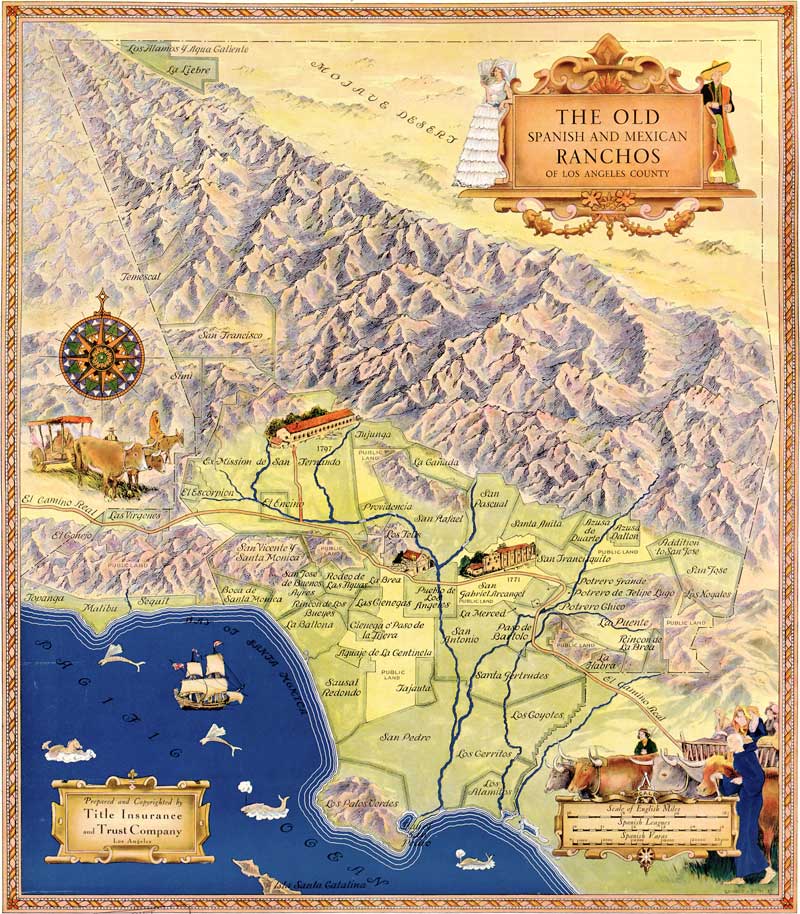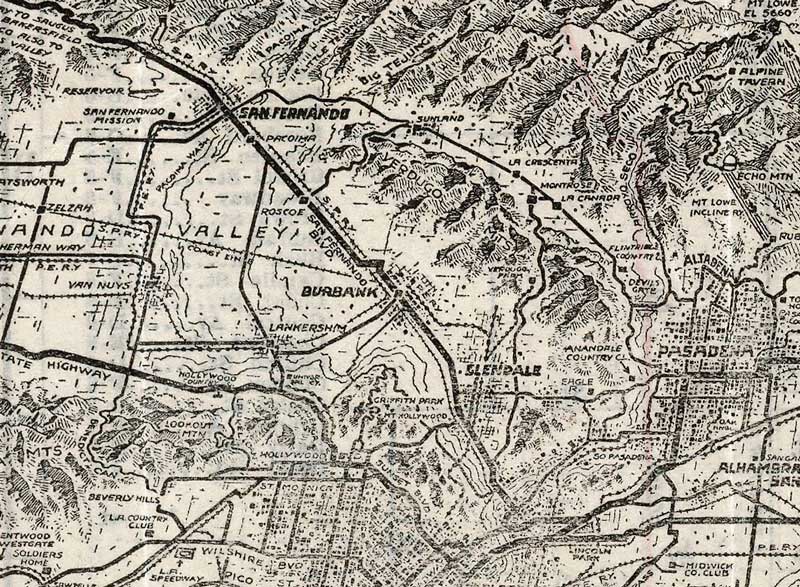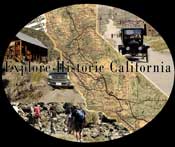“Our water
shed, the great Tujunga River, is ten times greater than
that which supplies Pasadena and the surrounding
territory. It is 50 times greater than the water
resources of famous Sierra Madre, and many times greater
than those of Monrovia. Any government contour map of
California will show this.”
M. V.
Hartranft early land promoter circa 1910
“Haines
Canyon ran like creek the year around from springs at
its head. Bluegum Canyon was gorged after heavy rains,
but ordinarily was dry. Blanchard Canyon, the same. Zachau
Canyon stood dry until rain water drained from the Seven
Hills watershed above Tujunga. And the Tujunga Canyon
Wash ran all year, alive with trout for the locals…
In the
first decade the settlers carried by hand all water for
their household needs or, until the first well was dug,
fetched it up by mule from the Wash.”
Charles
Miller, history columnist, Record Ledger 1986
|
 |
|
Title
Insurance and Trust Company 1937 map of Southern
California Spanish and Mexican Ranchos.
(Library of Congress Collection) |
Bertrand
Begue and his son Philip came to Los Angeles from San
Francisco following a smallpox epidemic which took his
beloved wife and daughter. Together they opened up a butcher
shop and would traverse by freight wagon to eastern Tujunga.
The local honey, deer, bear, and other game they found in
the green Verdugo Hills and surrounding areas was brought
back to their butcher shop to sell.
By 1882
Philip and his wife Franciscoa arrived in Rancho Tujunga
permanently to make a home as the first settlers in the
area. Lot 46 of Rancho La Canada and 10.92 acres of
property in the southern portion of present day Tujunga
Canyon Boulevard was purchased from Victor Beaudry , the
Cerro Gordo mining mogul and brother to former Los Angeles
Mayor Prudent Beaudry. The property cost five dollars an
acre, which was high at the time. In addition, the Begue’s
purchased water rights to Haines and Blanchard Canyons.
With
visions of grape vineyards on his properties, Begue faced
the problem of how to irrigate them. Wells and hand delivery
took care of the dilemma until he could build a reservoir in
Haines Canyon and pipe water down to the lower elevation
where the ranch was. Early reservoirs were small
sand-bottoms with pipes heading downhill, requiring regular
maintenance of the intake area to prevent clogging. By 1884,
a handful of land owners in neighboring Sunland including
William Bernhard, Alfred Adams, Loren Rowley, and others,
followed suit by installing a six inch pipe from Big Tujunga
Canyon to their orchards and vineyards.
Marshall
Hartranft was a land promoter and publisher of an
agricultural newspaper entitled The Los Angeles Daily
Fruit World, as well as a magazine entitled The
Western Empire. In 1907, he purchased 1,728 acres of
Tujunga land that had been set aside originally for a
college and educational center. To help put his theory
“population creates land values” to the test, he formed the
Western Empire Suburban Farms Association and purchased
Philip Begue’s water rights in Haines Canyon. To supplement
water supply needs, he also purchased Mary Ann Johnson’s
water rights in the Big Tujunga Canyon. Subscribers would
purchase bonds for road construction, sagebrush clearance,
and irrigation and domestic water. Each bond that was
purchased gave the holders the choice of waiting until the
land was paid for and take a profit, or they could exchange
the land for $300 an acre in bonds. Every bond entitled the
owner to one share in Hartranft’s Western Empire and one
share in the water company.
 |
|
The north east San Fernando Valley, including the
communities of Sunland and Tujunga are shown in this
1923 Southern Califonria Motorist Map.
(Rumsey Map Collection) |
The
Haines Canyon Water Company was formed in 1910. The water
came from two wells that augmented the gravity supply with
two unroofed concrete reservoirs and one large dirt
reservoir, both uncovered and unlined. As Marshall Hartranft
joined forces with William Smythe to create the utopian
Little Landers Colonies the populations grew with more
demands for wells and reservoirs. One reservoir was built
on Apperson Street with booster pumps to raise the water to
fill it. A second was built on Tujunga Canyon Blvd. and
Summitrose Ave. and a third built on Pinyon in 1929. The
Pinyon reservoir had a capacity of 750,000 gallons of water.
The water to fill it was raised 600 feet and passed through
the other reservoirs. This water supplied 5, 10, and 20 acre
parcels of land just east of Mount Gleason Avenue and west
to the Sunland olive and orange groves.
Maintenance on the water system was challenging. J. H.
Livingston was one of the men in charge of this daunting
task. The original pumps weren’t powerful enough and had to
be torn out and bigger ones installed. When pumping was
started to fill the reservoirs redwood plugs were driven in
to the ends of the laterals to keep the water climbing, but
as it reached the first of the laterals, the plugs blew out
and everything stopped so the plugs could be spiked in. Upon
a second start, the spike plugs held, but the next level of
laterals blew. This went on at each level, with plugs
continually blowing and more spiking required, until the
water found its way to the high reservoir. It was also
important for the man in charge of the pumps to know when
the reservoir was full. Mr. Livingston built a raft
outfitted with a red lantern, and floated it on top of the
water. Once he saw the red glow of the lantern above the
reservoir walls he knew it was time to stop pumping water.
Water was
relatively cheap at a cost of one dollar per 1000 acre feet
for domestic water and two and one-half cents an hour for
irrigation water. Both water came from the same pipes, but
the irrigation water had a schedule of delivery that was
arranged with the company and operated under the authority
of a “Zanchero”. Water meters were installed in 1923.
The
Haines Canyon Water Company sold to the American States
Water Company, eventually selling to the Los Angeles
Department of Water and Power. Another reservoir was built
with more pipes. Water would play a role in the battles over
Sunland/Tujunga’s eventual annexation to the City of Los
Angeles. The city would need the water to supplement their
supplies as it swelled to a huge metropolis, and the small
communities would benefit from supplemental water the city
could provide brought in from other areas in drought years.
